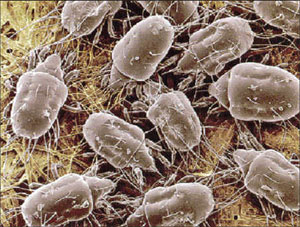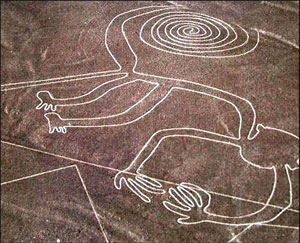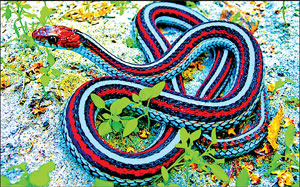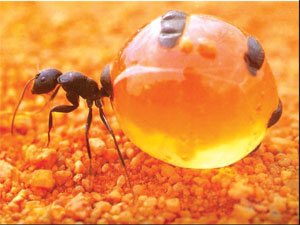|


The insect which makes a meal of your skin
A dust mite. A large part of house dust is made up of tiny flakes of
human skin. The house dust mite loves to eat this. And as it likes to
live in warm, damp conditions, it makes its home in beds, pillows and
mattresses which can also provide plenty of skin for it to feast on.
We cannot see the dust mite which lives in large numbers all over the
house. Most people are not affected by dust mites, however, some do
develop allergies and react to their bites.
Would you believe that tiny mites live even in the sockets of our
eyes? Do not worry about it because they do no harm .In fact they may
even help to keep our skin clean.
 What
the Nazca plain is famous for What
the Nazca plain is famous for
The Nazca plain which is very dry and flat with no sand to cover the
plain and little rain or wind, is famous for its drawings. It is
situated in Peru, South America. The strange lines in the desert
scratched on the ground are still a mystery. There are about 300 designs
of animals, birds, fish and insects that can be seen clearly on the
desert from the air. Some of these drawings, are more than two football
fields long.
These mysterious drawings are believed to have been work of Nazca
Indians who lived in the area between 300 BC and AD 800.
Since the Nazca lines were discovered many scientists have tried to
study their meaning but none have yet come up with an acceptable
explanation.
A scientist named Maria Reiche who spent over 50 years studying the
numerous lines and drawings had said "We will never know all the
answers." The biggest picture of the smallest bird in the world, the
humming bird is found here. Some of the other drawings found here are
the killer whale, pelican, monkey, tree, hands, astronaut, lizard, star
and flower.
 How
cold blooded creatures cope with heat How
cold blooded creatures cope with heat
Snakes, lizards and many other reptiles live in deserts.
Reptiles are cold blooded creatures. Their body temperature is not
controlled by a thermostat in their body like ours is. It is controlled
by their surroundings. Throughout the day they change their to position
regulate their temperature so they can stay active.
A desert lizard basks in the sun to warm up. When the sun blazes down
at midday, it moves into the shade to cool off. It sunbathes again in
the evening, so its body stays warm at night.
 What
the Barringer Crater is What
the Barringer Crater is
The Barringer Crater is a massive hole in the Arizona Desert in the
USA. It is nearly 1.5 kilometres (one mile) wide and 200 metres deep.
Its rim is made of smashed rock from inside the crater and rises 50
metres above the plain. Some lumps of rock are the size of houses. Its
other name is Meteor Crater, which tells us how it got there
 Why
honeypot ants take other insects prisoner Why
honeypot ants take other insects prisoner
Honeypot ants live in a colony. Most kinds feed on nectar they gather
from flowers but some get their food from an amazing source. They
capture aphids or cochineal insects and keep them captive in their
nests. The ants stroke their prisoners with their antennae (feelers), to
make the insects produce honeydew, a sweet liquid for the colony to
drink.
Honeypot ants were first documented in 1881 by Henry C. McCook.Many
insects, notably honey bees and some wasps, collect and store liquid for
use at a later date. However, these insects store their food within
their nest or in combs. Honey ants are unique in using their own bodies
as living storage, but they have more functions than just storing food.
Some store liquids, body fat, and water from insect prey brought to
them by worker ants. They can later serve as a food source for their
fellow ants when food is otherwise scarce. When the liquid stored inside
a honeypot ant is needed, the worker ants stroke the antennae of the
honeypot ant, causing the honeypot ant to regurgitate the stored liquid.
In certain places such as the Australian Outback, honeypot ants are
eaten by Aboriginal people as sweets and are considered a delicacy.
Some worker ants turn into honeypots right from their emergence from
pupa stage. The young ants stay in the nest, and the worker ants who
collect honey feed them. As they feed more honey than they need, the
surplus honey gets stored in their abdomen. As their abdomen expand, the
ants lose their mobility. |



